
|
Outdated Template In Use! | |
| Please note that the template that you are using is outdated. This may cause issues with the template, the page and the wider Particracy Wiki! Please the current list of supported and up to date templates located here: Templates Manual of Style. If you need assistance please contact Wiki Administrator Auditorii via the in-game forums or Discord. |
| Repubblica Istaliana | |||
|---|---|---|---|
| Istalia | |||

| |||
| Motto:Patriae unitati et Civium libertati | |||
| Anthem:Fratelli d'Istalia | |||
| Map | |||
| Area | 669.600km² | ||
| Regione | |||
| Ingrisu; Cisavugli; Nicoma; Feirano; Teracche. | |||
| Government | |||
| Government Type | Parliamentary republic | ||
| Presidente della Repubblica | Michele Carta | ||
| Head of State Party | Partito Borisista Istaliano | ||
| Demographics | |||
| Language | Istalian | ||
| Capital | Romula | ||
| Largest City | Romula | ||
| Population | 80.948.980 (2312 est.) | ||
| Density | 119,87 per km² | ||
| Founded | 2097 | ||
| Currency | Istalian Lira | ||
| Currency Abbreviation | LIS | ||
| Sport | Calcio | ||
| Animal | Lupa Capitolina | ||
| Nation ID Number:39 | |||
Istalia, formerly Repubblica Istaliana (english: Istaly, Istalian Republic), is a nation that lies on the south-eastern top of the Majatran continent, bordering with the Solentian Empire on the west, surrounded by the Sea of Lost Souls on the north and by the Perarctic Ocean on the south. The nation consists of 5 regions, called regioni, of which 3 are located on the peninsular part of the country, and the other two lie on an east island (called Estalia) of the peninsula.
History
Fist settlements and Middle Ages
First settlers
Historians set the most ancient documentation about human presence on the Istalian region back in 3000 BC: several small towns were discovered on 1950 in the Estalia island in which lived a society that relied on a rudimental fishing economy. Therefore this group never expanded outside of the isle as conquering the semi-arid peninsula would have been too much of a worry rather than an opportunity for the islanders. Famous is however the travel of Federicus the Brown, a mythical navigator who explored the continent's coast, arriving to the inner sea of Majatra.
The Estalian Kingdoms
After years of turbulence, on 520 AD the first Estalian kingdom was created. Lorenzo I took the power on Palerno and expanded his influence throughout the entire region. The famous Estalian galees allowed complete dominance over the Sea of Souls, thus giving a strong boost towards the development of a healthy trading economy. In the same time, the first colonization of the peninsula started with the foundation of the cities of Reggio Ingris and Barri.
On the subsequent century, the Estaliani continued to colonize the peninsula, but the growing distance from the kingdom capital situated on the island and its influence became an excuse for local lords of the peninsula to gain more power and autonomy, as the central government progressively lost authority over these lands. The internal division was explicit when, on 1434, the duke of Milona Ambrogio Negroni proclaimed himself re di Padagna, causing a political fragmentation that would endure for the next three centuries. Therefore, at this stage there were two kingdoms possessing the same cultural roots: the Estalian Kingdom, whose inhabitants were the former and first Estalians, and the Padagna Kingdom, as a result of the declaration of independence carried out by Negroni.
Many were the reasons of this division: cultural, because the inhabitants of the peninsula started to differ from those of the isle as in language and common habits; political, since the central government had an oppressive tax policy over their colonies; economical, as the isle was slowly becoming dependant on these colonies that were growing and becoming quite productive: the presence of such government was perceived only as a heavy toll suffucating their possibilities of development.
The foreign occupation
Rise of the Quanzari Emirate
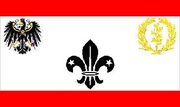
The flag of the Emirate
The fledging kingdom of Padagna held a territory rich of raw materials. It had a wide capability of supporting a strong economy and a flourishing society, although it was very poor at start. Things started out well however for the newborn kingdom, while the originary Estalian kingdom faced trouble on struggling to maintain economical growth and avoid a depression, as the government had maintained throughout years of well-being very lax economical policies, having been semi-dependant from the colonies until their indipendence. This state of transitory weakness of both kingdoms led the emergent Q'nzars, an ethnicity originary from east of the continent, to set their aim upon the Istalian region (the corruption of the name Estalia). The Padagna army, formed principally by reservists and volunteers was defeated in four months, as the kingdom spent two centuries in raising from scratch a good economy: military was neither an issue nor a priority nor they could afford such an expense in those times of relative peace. Continuing its offensive campaign, the foreigners took, on 1771, the entire control of the peninsula, with the decisive battle at the gates of Reggio Ingris. Resistants fled the country asking for political asylum to the old Nicomese kingdom, which accepts them in name of their traditional national brotherhood.
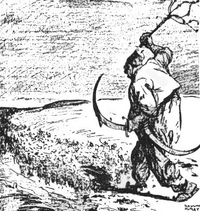
A caricature of the Quanzari oppression
Ended the war, the Q'nzars created the Quanzari Emirate (ar: كانزاري الامار), an oligarchy ruled by the emir Muhammad Al'Bner.
Istalian resistance
The occupation of the peninsula triggered the formation of unresting movements, as, among the others, intellectual manifestos like the works of Emanuele Terenzi, one of the most known authors of the 19th century. After the boycottage of Quanzar monopolies (like tobacco), the Istalians started to create secret societies as Istalia Libera and Resistenza Nicomese. The Quanzari Emirate tried to counter the uprising Istalian majority by giving the military the order to control the nation as a de-facto police force. Exiled refugees, principally on Solentia, started to support the resistance with donations. Famous is the creation of the Istalian Liberation Grant.
The Istalian kingdom (this is how the Nicomese one was renamed after the invasion), now alone in fighting the Quanzarians, was formerly taken by the emirate on 1956. Also if the island was defined as Quanzari Dominion of Estalia (ar: كانزاري السياده من ستاليا), de facto it remained an independent state, where the Muslims did not take part. Several times the peninsular Istalians asked them to lead the resistance, but the kingdom was too weak to support these pleas.
The collapse of the Emirate
The situation tended to collapse in the following 50 years. Most of the Quanzars, finally integrated with Istalians, decided that the old Emirate should end, also because the civil liberties were very little, since the Sharia was bound as national law soonly after the ultimation of the Quanzari military campaign. In this period communists forces surges in the entire nation, and finally, on 2110, a revolution starts against the ruling class but also against the Istalian king.
The compromise: the Soviet Union
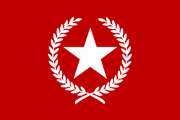
The flag of the Union
Created on 2118, the Union of Quanzari Soviets was an experiment of convivence between the Istalian majority and the Quanzar minority. After the overpower of the orthodox Muslims, the creation of a complete atheist state was the idea about a possibility to forget the precedent history of oppression.
It works and for about 200 year the nation continues to maintain its integrity. But the nationalized economy and the lack of civil liberties start to make citizens unhappy. This is why the People's Assembly divided itself in different wings, but in the last years the more democratic forces taken the control of the country and start to change it in a more liberal state. It was in this times that the founders of Partito Social-liberista and Alleanza delle Libertà (also if this parties was not yet formally recognized) started to think about possible institutional changes.
The return of Istalians
Transitional times: the Repubblica Quanzariana
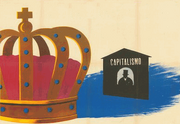
A propaganda poster against the reintroduction of the Istalian monarchy, titled On the shadow of the crown.
On July 26, 2233 the Parliament of the Union of Quanzari Soviets solemnly proclaim the creation of the Repubblica Quanzariana. The name was chosen on Quanzaria because the old Nicomese real dynasty, after the collapse of the Union, start a small insurgence on the Eastalian island, in order to restore the old kingdom. The disputed was resolved by a referendum in the island: the majority (87%) of citizens decide to become part of the republic. The Parlamento Quanzariano transform then Kisawuli and Nicoma in two semi-independent regions.
It is in this transitional period that most of the current parties was founded: the Partito Social-liberista (formally recognized but active also on the Union), the Partito Borisista, the Partito Laico Riformista and the Partito Collettivista Internazionalista. On formerly ones, the most important were Alleanza per le Libertà (co-founder with PSLI) and the Partito Libertario. The first Presidente della Repubblica was Marco Guadagnini (PSL).
The national restoration: the Repubblica Istaliana
After 30 years of democratic government, the PSLI decides to start a constitutional, historical change: formally recognize the Istalianity of the nation and change its name to Repubblica Istaliana. Followed by all parties on the parliament, the constitutional law passed with unanimity. Then, on May 2 2263, the Presidente della Repubblica Carlo Aurelio Gianti proclaims the creation of the Repubblica Istaliana with this speech:

President Gianti proclaims the Repubblica Istaliana
«Cari cittadini istaliani,
è con immenso piacere che sono qui nel Parlamento, ora Parlamento Istaliano, per proclamare la nostra repubblica Repubblica Istaliana. Dopo secoli di divisioni la nostra patria è ora una, libera ed indivisibile. Il sogno antico dei nostri padri è ora realtà: gli istaliani sono liberi, con una nazione dove la democrazia è sacra ed intoccabile. Evviva la Repubblica! Viva l'Istalia!» |
«Dear Istalian citizens,
it's with extreme pleasure that I'm here, in the Parliament, now the Istalian Parliament, to proclaim our republic, the Istalian Republic. After centuries of divisions our nation is now one, free and indivisible. The old dream of our fathers is now reality: Istalians are free and they have a country where democracy is sacred and untouchable. Long live the Republic! Long live Istalia!» |
(Carlo Aurelio Gianti, Extract from the Speech for the Proclamation of the Istalian Republic)
| |
Government
Istalian parties are bound in two coalitions: the Fronte di Liberazione Nazionale (centre-right) and the Fronte Popolare Istaliano (centre-left). Although these coalitions do not always reflect an unanimous expression of their parties' ideology, it is safe to declare that they express a coherent opposition in terms of economics, while social matters represent instead a completely different 'wing' or union of Istalian politics.
Currently, there are 7 parties in Istalia:
- Fronte di Liberazione Nazionale:
- Avanti Istalia!
- Democrazia Nazionale
- Partito Nazionalista Istaliano
- Partito Integralista Cristiano
- Fronte Popolare Istaliano:
Foreign Affairs
The nation of Istalia has always been neutral when coming to Foreign Affairs. It is convinced on the cooperation with others Majatran nation and then it is member of the Majatran common market. It is a strong supporter of the international aid, and it is the head of the International Red Cross.
See also
Geography
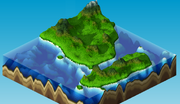
The Istalian peninsula from S-W
Climate
Regions
Istalia is divided into five regions. They are:
Economy - Economia
Principal sectors
- For GDP variations, see here.
Demographics
Population
In February 2373, there are 97.571.320 people residing in Istalia.
Important Marks
As in August 2308, Istalian population reaches mark 80 million: 2308 census reports 80.006.029 people living in Istalia.
Language
The main language in Istalia is, of course, the Istalian. However, people usually use regional dialects, different from West to East of the country. This is due by the secular division between the two old kingdoms , the Regno di Padagna and the Regno Nicomese which was enlarged during the Quanzari dominion.
Religion
Ethnicity
Public Holidays
| Holiday | Date |
| Festa della Repubblica | May 2nd |
| Festa della Liberazione Nazionale | July 26th |
| Festa della Vittoria | November 5th |
| Christmas Day | December 25th |
| Nations of Majatra | |
|
| |

